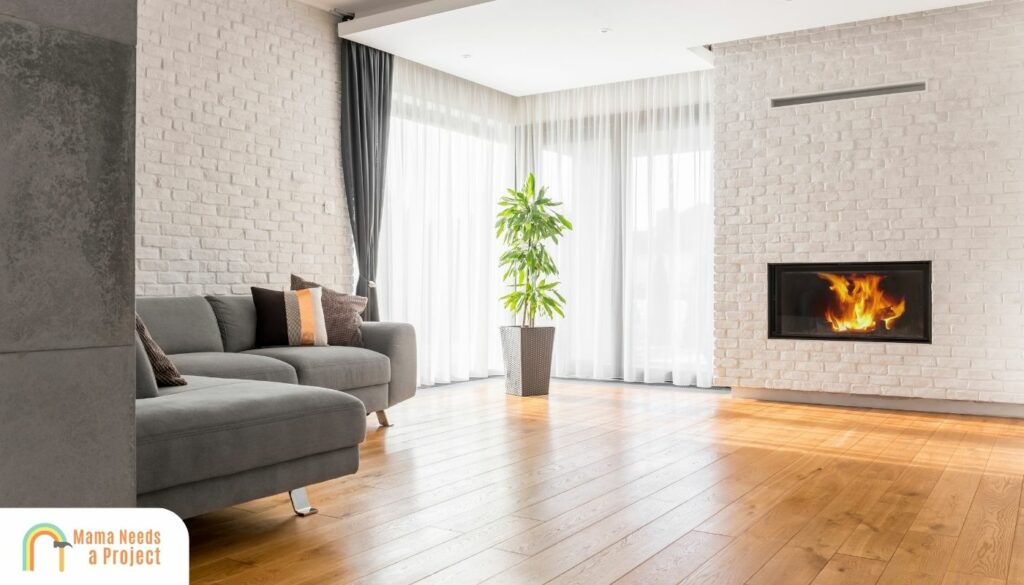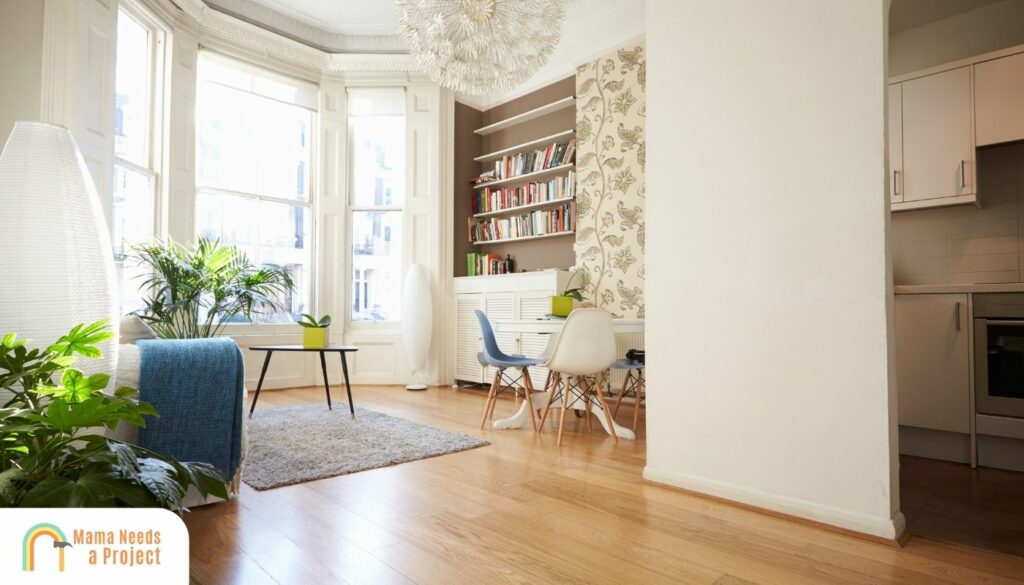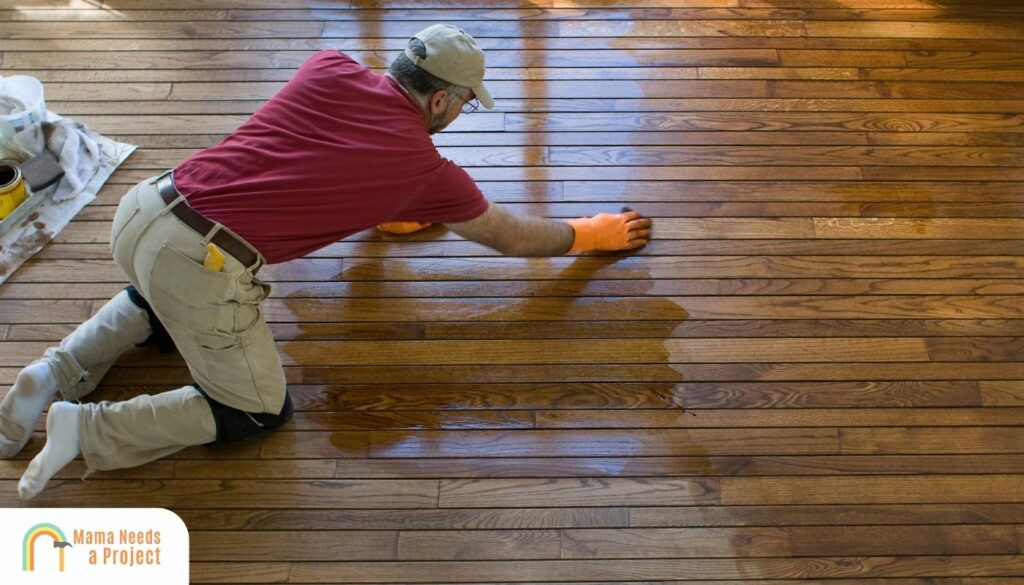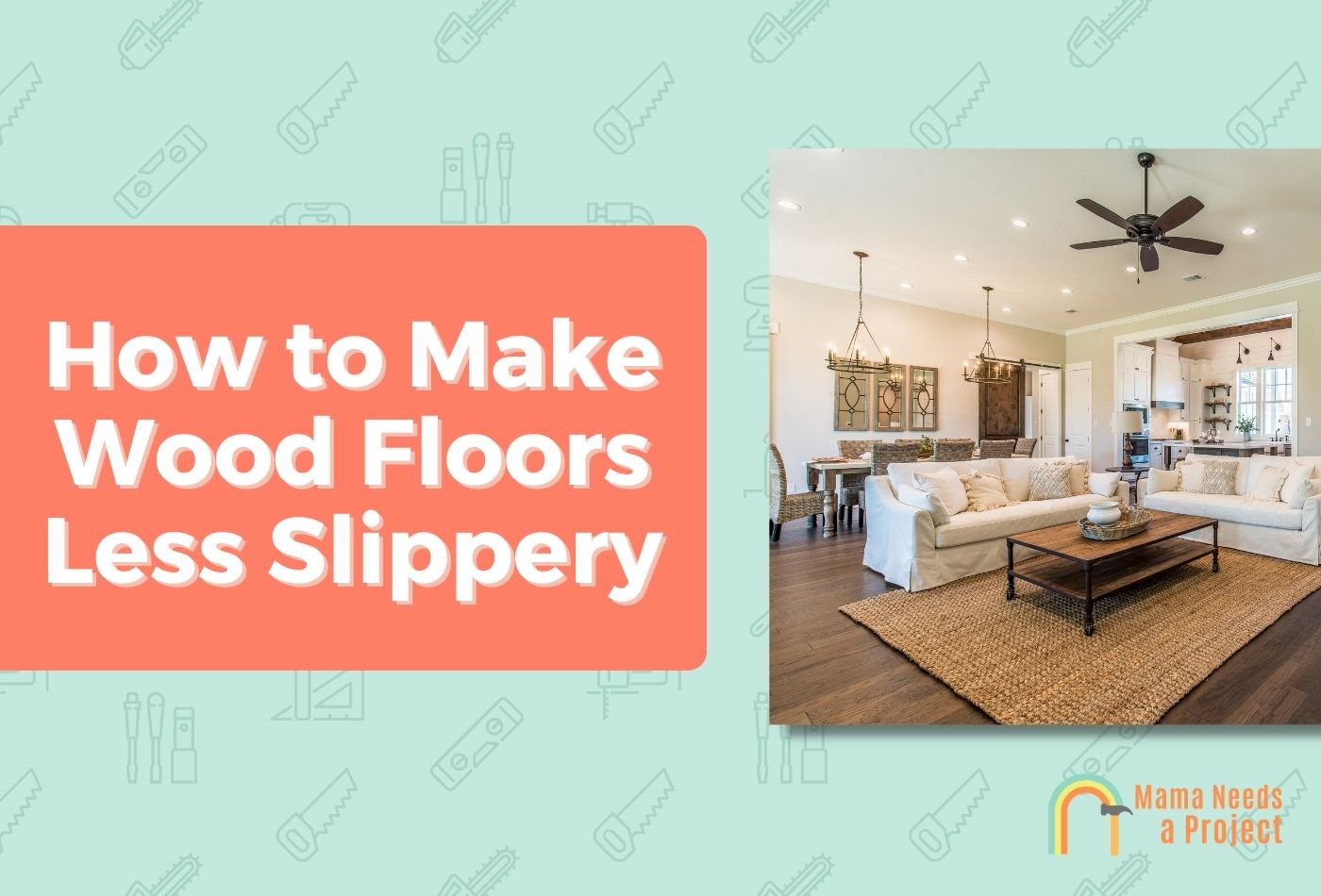How to Make Wood Floors Less Slippery (Ultimate 2024 Guide)
Do you have a slippery floor? I love the look and feel of my wood floors, but like any homeowner with hardwood flooring, I’ve had my share of slips and slides – which can be a huge issue!
So if you’re wondering how to make wood floors less slippery, check out these fast and effective methods to make your floors a little more safe. Let’s dig in!
- You can make your wood floors less slippery with frequent cleaning and by using area rugs and door mats.
- Hardwood floors will look great for decades with proper maintenance, including recoating and refinishing as needed.
7 Effective Methods for Fixing Slippery Floors
The timeless and classic appeal of wood floors is hard to resist, but slick floors can be dangerous. Here are some effective methods for fixing slippery wood floors!
1. Frequent Cleaning

Frequent cleaning is one of the most important ways to keep your wood floors from being slippery. Over time, a layer of dirt and grime builds up on your floors, causing them to be slick.
Sweeping or dry mopping your floors daily will help prevent that grimy build-up that causes slippery hardwood floors. Frequent cleaning doesn’t mean mopping all the time, though, because cleaning solutions can also make your hardwood floor slippery when you overdo it.
Hardwood floors should be swept daily and mopped with a damp microfiber mop about twice a month. You should also wipe spills immediately because they not only make your floors slippery but can also cause other problems.
Remember, the goal is to keep your floors as clean and dry as possible.
2. Door Mats and Area Rugs

Area rugs placed strategically throughout your home will provide traction in places prone to being slippery. You have to use non slip rug pads, though, so your area rugs don’t become tripping hazards and make matters worse.
I use welcome mats outside on the porch to keep debris from getting tracked in, and I also use a traditional door mat right inside the entry to trap dirt and moisture and keep them off the floor.
I also use floor runners with non slip pads to help protect the floor in high-traffic areas and keep pets and family members from slipping.
3. Anti Slip Floor Coatings
Nobody wants to ruin the gorgeous look of their expensive hardwood floors with the wrong type of floor coating. But in some parts of your home, where moisture issues are common, your wood floors can be treacherous.
Anti-slip coatings for slippery hardwood floors make a huge difference in problem areas like bathrooms, laundry rooms, and kitchens. You have several anti-slip products to choose from, including nonskid paint additives that you can add to a sealant. and anti-slip epoxy spray.
I use anti-slip treatments in my kitchen and bathroom. It makes getting in and out of the shower a lot less scary, and I don’t have to worry about sliding around in the kitchen, which is one of the worst places for slippery floors.
- THE ORIGINAL EXTRA STRONG GRIPPER: our trusted Gorilla Grip nonadhesive rug pads offer a unique, dual sided…
- REDUCES RUG BUNCHING AND SLIDING: slip resistant pads help reduce rug bunching and sliding, even over high…
- SUPERIOR FLOOR PROTECTION: open grid design allows floors to breathe and helps protect from damage; rug pads…
4. Non-Skid Paints
Innovations in paint technology have brought some amazing products to the market. There are so many options available that will make your wood floors look amazing while protecting them and making them less slippery at the same time.
Nonskid paints contain grit or other anti-slip additives that make your hardwood floor less slippery while still creating a beautiful finish. Choose from water-based and oil-based polyurethanes and epoxy finishes and find a color that complements your home’s interior.
5. Use a Natural Oil Finish
Water is one of the biggest enemies of wood floors, so you have to protect it with some kind of finish. Even though it might not seem to make sense, natural oil finishes are less slippery than other types of finishes, like wax and epoxy coatings.
Oil finishes penetrate deep into wood floors, so they protect the wood. They are the best finish for high-traffic areas, which can start to look dull with other types of finishes.
With an oil finish, all you need to do is clean your floors to bring them back to their original luster. You should re-oil your hardwood floors every one to two years.
You can’t use natural oil finishes on top of other types of floor coatings, though. That would make your wood floors even more slippery!
6. Apply Anti Slip Tiles
If you have a slippery floor, it’s important to find a method to make it safe, so as a last resort, another option you have is to apply anti-slip tiles to wood floors.
Self-adhesive anti-slip tiles are an easy way to fix your hardwood floor in problem areas, and best of all, anyone can install them.
Anti-slip tiles are made out of rubber or PVC materials, so they are long-lasting. They are also easy to remove if you ever want to restore your wood floors.
7. Restore Your Wood Floors

Hardwood floors can last a lifetime, but that doesn’t mean they last forever. If you’ve already tried everything else, and your floors are still slippery, your only solution may be to sand and refinish them.
Most wood floors need to be restored every 7 to 10 years, depending on how much traffic they get and how well they are maintained.
Why Do Wood Floors Get So Slippery?
Hardwood floors aren’t inherently slippery, so why do they get so slick? Learn more about the dangers of wood floors and what causes them to be slippery.
Dangers of Slippery Wood Floors
It’s no surprise that children and the elderly are at more risk of injury, but did you know that according to the National Floor Safety Institute, over 8 million people go to the emergency room each year due to slips and falls? Slips and falls can even cause life-threatening injuries.
Over half of all injuries happen at home, and falls are the most common type of household accident. Slips and falls can be serious, especially the older you get, causing sprains, broken bones, soft tissue injuries, and concussions.
Causes of Slippery Wood Floors
It’s important to take steps to make your home as safe as possible, and it helps to understand the causes of slippery wooden floors so you can avoid them.
When you take a step on your hardwood floor, you rely on the friction of your shoes or feet on the surface to move safely. The following issues reduce the amount of friction, leading to slips and falls.
- Moisture and Humidity: wet floors reduce traction, so they’re more slippery
- Grease: oil droplets from cooking are a common problem in kitchens
- Dust and Loose Dirt: it reduces the amount of friction, and it’s worse when it gets wet
- Dirty Footwear: tracks in dirt, oils, and wax residue from other floors and surfaces
- Soap Residue: soap works as a surfactant, which reduces friction to dislodge dirt and oil, so it will make your wood floor slippery
- Cleaning Solutions: some leave a film that can build up over time, making your floors more and more slippery
- Normal Wear and Tear: worn wood floors are smooth, which reduces friction
- Waxed or Polished Wood Floors: wax residue fills the gaps in your wood floor, making them smooth
You can avoid many of the causes of slippery wood flooring by asking people to take their shoes off at the door. Bare feet and nonskid footwear are the best choices indoors.
Techniques and Tips for Cleaning Hardwood Floors
As we’ve seen, improper cleaning methods, wax residue, and built-up dirt and grime make your floors slippery. Floors get dirty no matter what you do, so for the best results, follow these tips for cleaning your hardwood floors.
Effective Cleaning Methods
To maintain clean floors, the important things to remember are to avoid excess moisture and to keep your floor dry as much as possible.
Developing a daily sweeping routine will help prevent the build-up of grime and reduce the wear and tear caused by loose dirt on your hardwood floors.
Vacuuming with the hard floor setting once a week is sufficient. Mopping only needs to be done every two to four weeks. The best cleaning solution for wooden floors is a mild vinegar solution.
If you need, you can use a mild detergent, but be sure to wring as much water as you can out of your mop to avoid using excess water.
Want to know the different ways to clean hardwood? Check out the video down below!
Recoating vs. Refinishing Wood Floors
If your hardwood floor is in really bad condition, it will probably need to be refinished. In some cases, though, you can simply reseal it, saving yourself a lot of time, money, and elbow grease.
Assessing Your Wood Floor
A wooden floor can be refinished every 7 to 10 years, and it can be refinished four to six times before it needs to be replaced. That means your wood flooring can easily last 60 years or more.
Before you take any further steps, the wood surface be properly assessed.
- Visual inspection: Note defects like scratches, dents, splinters, and worn areas on your hardwood floor. Pay particular attention to any discoloration or dullness of the finish.
- Feel the floor: Knowing the type of finish is also an important part of determining what steps you need to take. Feel the surface of your floor. If you can feel the wood grains, you have a penetrating finish.
- Spot test: You can also spot-test a small section of your floor with paint remover. Choose an out-of-sight location, and if the finish bubbles, then you have a surface finish, like polyurethane.
- Water test: Find the most worn part of your hardwood floor, and place a few drops of water on the surface. If the water beads up, then the wood sealant is doing its job. If the water is absorbed, it’s time to refinish your floors.
Recoating Your Hardwood Floors
Recoating your hardwood floors is a lot of work, but anyone can do it. I have done it a couple of times myself, and the results are impressive!
Restore Your Floor Without Sanding
Recoating your wood floor, also known as “buff and recoat” or “screen and recoat,” is the best solution when there is minor damage and the finish is still intact.
Recoating is considered part of routine floor maintenance, so anyone with a wooden floor should be familiar with the process. The good news is you don’t have to sand your floor to recoat it, but there’s still a lot of work involved.
Prepare the room by removing everything and cleaning the floor with mild detergent. Allow it to dry completely, then buff the floor and apply the finish according to the type and manufacturer’s directions.
Types of Floor Coatings for Wood Floors
If you’re recoating your hardwood floors, you may be limited to what type of product you can use, depending on what’s already there.
Here are the most common types of hardwood floor finishes:
- Solvent-borne and water-borne polyurethane
- Moisture cured polyurethane
- Wax
- Shellac
- Varnish
- Natural oil finish
Refinishing a Wood Floor: DIY vs. Professional
Recoating has limitations. It won’t get rid of the scratches and dents on your floor or bring faded wood back to life. If the coating on your wooden floor is worn or your floorboards are damaged, you should consider refinishing.
Pros and Cons of DIY Restoration
If you have the time and the DIY skills, restoring your hardwood floors is a great option. It will save you a lot of money, and you get the satisfaction of transforming your floor.
However, it’s not for everyone. It is a time-consuming job, and since you also need to live in your home, timing is critical. It’s an extremely messy job, which isn’t everyone’s cup of tea. Plus, if you don’t know what you’re doing, you can ruin an expensive floor.
Advantages of Hiring a Professional
When you hire a professional, you get the benefit of their expertise, and if you hire the right person, you can rest assured that the job will be done satisfactorily. Professionals provide fast, quality service because that’s how they stay in business.
Another important consideration is material warranties. If your floor is still under warranty, it may require professional restoration to retain the warranty’s coverage.
FAQs
Why are my hardwood floors suddenly slippery?
If you suddenly notice that your hardwood floors are slippery, review the list of common causes to determine the reason. Sometimes the cause is something simple like someone wearing gym shoes in your house tracked wax on your floor.
How do you shine hardwood floors without making them slippery?
The best way to shine your hardwood floors depends on the type of finish you have. One of the best ways to make your floors shine is simply to clean them with a vinegar solution. Mix about 1/4 cup of vinegar with a gallon of water, and wring your mop well to avoid excess moisture.
Does vinegar help slippery floors?
A vinegar solution will remove wax residue, soap buildup, and grime to help make your floors less slippery. Don’t use too much, though, because the acid in the vinegar will eat away at the finish on your floor.
How do you add traction to wood floors?
You can add traction to wood floors with anti-slip coatings, nonskid paints, and epoxy sprays. You can use any of several anti-slip treatments on problem areas like bathroom floors and stairs. Some of them are rolled on, and some are applied by spraying. Another option is to use door mats, area rugs, and non slip pads in high-traffic areas.
How can I make my wood floors less slippery for my dog?
When your dog slips on your hardwood flooring, it not only damages your floor, but it can also hurt your dog. Anything you do to make your floor less slippery for humans will also work to make it safer for your dog. You can also use anti-slip paw grips or dog socks for your dog and keep their nails trimmed.
Final Thoughts
With a few simple strategies, you can keep your floors looking great and prevent them from getting slippery. Develop a cleaning routine, and maintain your wooden floors properly so they’ll last a lifetime. Utilize door mats, area rugs, and non slip coatings in problem areas to ensure your family’s safety, and you’ll never have to worry about your floors being slippery again.



